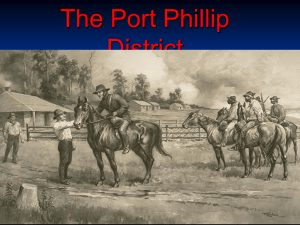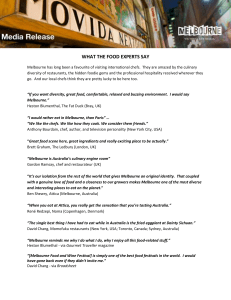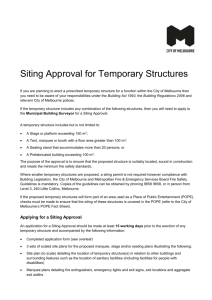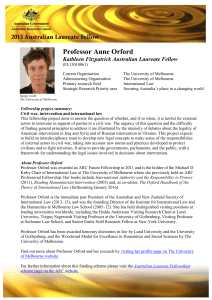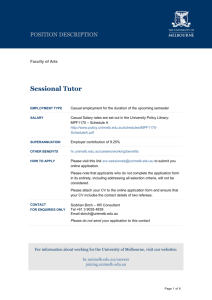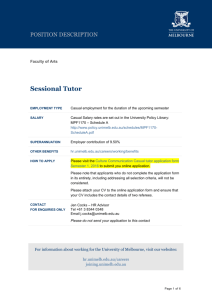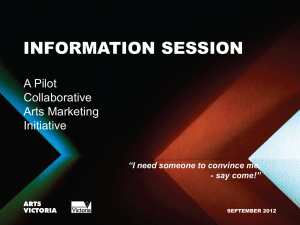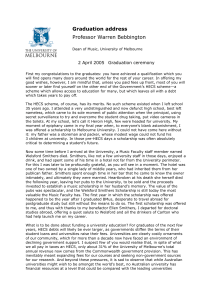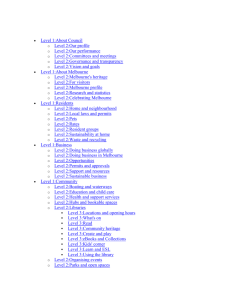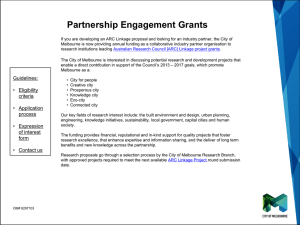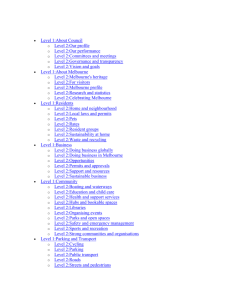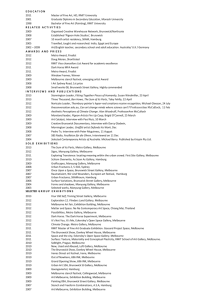Australia and WW2: On the Home Front
advertisement
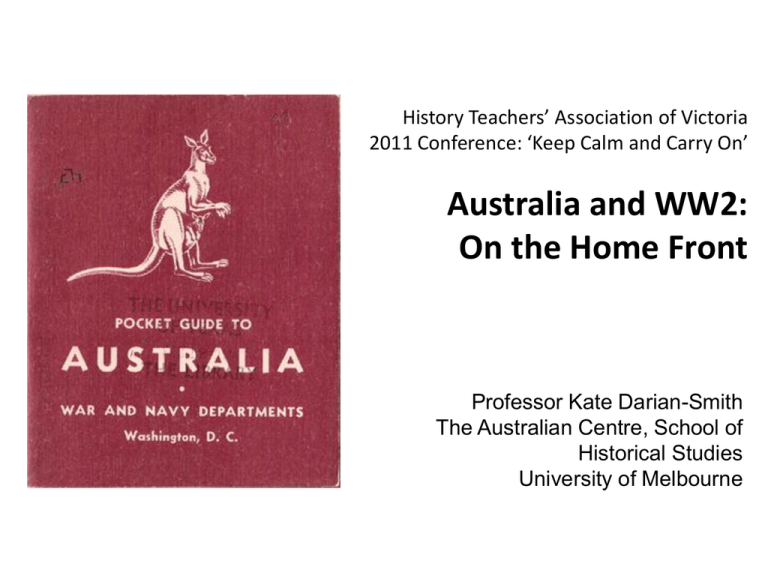
History Teachers’ Association of Victoria 2011 Conference: ‘Keep Calm and Carry On’ Australia and WW2: On the Home Front Professor Kate Darian-Smith The Australian Centre, School of Historical Studies University of Melbourne ‘Dig for Victory’ campaign – launched in Australia by Prime Minister John Curtin in 1942. LEFT: Commonwealth Food Control (ARTV02474) and RIGHT: Department of Commerce and Agriculture (ARTV02452) LEFT: Commonwealth Food Control (ARTV00161) and Department of Commerce and Agriculture (ARTV02158) James Northfield, ‘A united 'Fighting Mad' Australia - can never be enslaved’, 1942-1944, State Library of Victoria. H.B. Armstrong, ‘Don't spill the good oil’, 1943, Australian War Memorial, ARTV07818 The Squander Bug, Australian War Memorial, RC02344 & RC02345 The Squander Bug in Australia (LEFT) and Britain (RIGHT) http://www.youtube.com/watch?v=wfLdAxc32mM The Second World War 1939-1945 • Military Fronts • From 1939 in Europe and the Middle East • From 1941 in the Asia-Pacific - following the bombing of Pearl Harbor • Distance and proximity between the military and civilian (home) fronts 1942 • Period of national uncertainty and anxiety, following the advance of Japanese through S-E Asia, and fall of Singapore • Visible signs of war: air raid precautions, ‘brownout’ • Australia looks to US for military protection The impregnable British Fortress at Singapore fell to Japan in February 1942. Over 15 000 Australians were taken prisoner. ‘All-In’ War Effort • Conflict or Unity? • Impact of military enlistment on society • Expansion of industrial base - for instance, Melbourne the hub of the national armaments industry • Labour shortages and demands • Shortages of goods and rationing Leads to… • Generational differences understanding war in context of generations • Shifts in expectations about gendered behaviours • Greater mobility - occupational, physical, socio-economic • New definitions of femininity and masculinity in context of patriotism Paid Employment • Labour shortage acute by 1941 • Manpower Directorate formed to register and control all labour by 1942 • Need to attract women into ‘war jobs’ • So - new type of patriotic woman engaged in war-related paid employment Feminine Patriotism – Voluntary Work • Experiences of voluntary work in WW1 • With WW2, popularity of voluntary paramilitary organisations • Federal government had a National Voluntary Register - 30,000 names by 1940 • Middle class participation Women making flares Melbourne 1941 Women and Paid Employment • In 1939, 644,000 women recorded as being in paid employment; rising to 855,000 by 1944 • At peak in 1944, women’s employment represented 25% of labour force - up about 2% on immediate prewar and post-war figures But… • Type of work women did was overwhelmingly traditional ‘women’s work’ • Some positions that had been held by men were taken over by women ‘for the duration’ • Women’s Employment Board appointed • War strengthened demarcation between men and women’s jobs, and did little to encourage equal pay New Alignment of Paid Work with Patriotism • Media and government campaigns to ‘lure’ women into workforce • Civilian positions • Auxiliary military forces • Women’s Land Army • But revealed tensions between women’s role as ‘home-makers’ and as workers Femininity and Sexuality • Changing concepts of femininity in interwar years (Lake) - new expressions of sexuality • In wartime, new emphasis on women’s sexuality and how it could be ‘controlled’ to further war effort • War also sparked a new examination and emphasis on the family Albert Tucker Victory Girls 1943 Control of Sexuality • • • • • Policing of Public Behavior Prostitution Venereal Disease Contraception Legislative changes - ie restricting women’s access to alcohol • Enforced Detainment and Imprisonment • Women’s Loss of Civil Liberties Learning to Jitterbug in Melbourne Australia looks to America • 27 December 1941 Prime Minister Curtin delivers his famous New Year’s message to the nation… • ‘I make it quite clear that Australia looks to America, free of any pangs as to our traditional links or kinship with the United States….’ Balance of the Sexes • Arrival of the US Forces: 30,000 in Melbourne by May 1942 • ‘Victory Girls’ • Leonski • Marriage Rate – increase • ‘War Fever’ The South West Pacific Theatre Part of the 7th Marine Camp, Mount Martha Party, Melbourne Cricket Ground, Marines and Aussies line up for beer U. S. Marines in Melbourne • St Kilda and Luna Park • Walks along the Yarra River and in the Botanic Gardens • Dancing at the Palm Grove and the Trocadero • Eating steak and eggs at military clubs like The Dug-Out •Riding the trams •Shopping; attending movies, the theatre and the races • ‘Chloe’ in Young and Jacksons’ hotel. War Brides Article about Robert Barton and Shirley Pearce, Melbourne Herald Sun, June 14, 1993 Russell and Patricia Pope (Bob Barton in background) At their wedding in Melbourne A War Bride’s Tale: Dawne and Fred Balester 17-year old Melbourne girl Dawne McLeod-Sharpe met her future husband — Marine corporal Fred Balester — in a chance encounter at Flinders Street Station in 1943. Conscious that he was returning to battle, Fred decided it was not in Dawne’s best interest for them to marry in haste. They wrote regularly and Fred finally proposed by letter in 1945. Along with many other Australian war brides, Dawne embarked on the lengthy sea voyage to the US and on the SS Monterey in 1946. After three years apart, the couple were married within a week of her arrival in Wilkes-Barre, Pennsylvania and honeymooned at Niagara Falls. Their happy union ended when Fred died in early 2009. Dawne, who brought up five children in the U.S., feels tied to both countries: ‘when I am in America, Australia is home, and when I am in Australia, America is home’. http://history.unimelb.edu.au/overhere/a-war-bridestale.html Wedding of Fred and Dawne Balester, Wilkes-Barre, Pennsylvania, USA, 1946 Long-term friendships Melbourne ‘Moms’ Many young Marines became substitute sons to Melbourne women whose own sons were serving abroad. Mrs. Doris MacKenzie of East St. Kilda ‘adopted’ Marine private Jack Callaghan, and cared for him as one of her own. She sent long letters of reassurance to his mother in Oklahoma. My dear Mrs. Callaghan - You no doubt will be surprised to hear from me but I am writing to let you know where your son “Jack” is. I have had him staying with me and my family and I might tell you my dear that he is having a good rest and is looking wonderfully well. They have been here about 2 months. We have grown so fond of “Jack”, and he is one of the family. He says we remind him so much of home. I try to cook him things that he used to get at home. He is a great kid. I have only one son and he is in uniform too. He is a great pal of Jack’s…They go everywhere together. http://history.unimelb.edu.au//overhere/melbourne-moms.html Further resources http://www.history.unimelb.edu.au/overhere/indexmain.html




